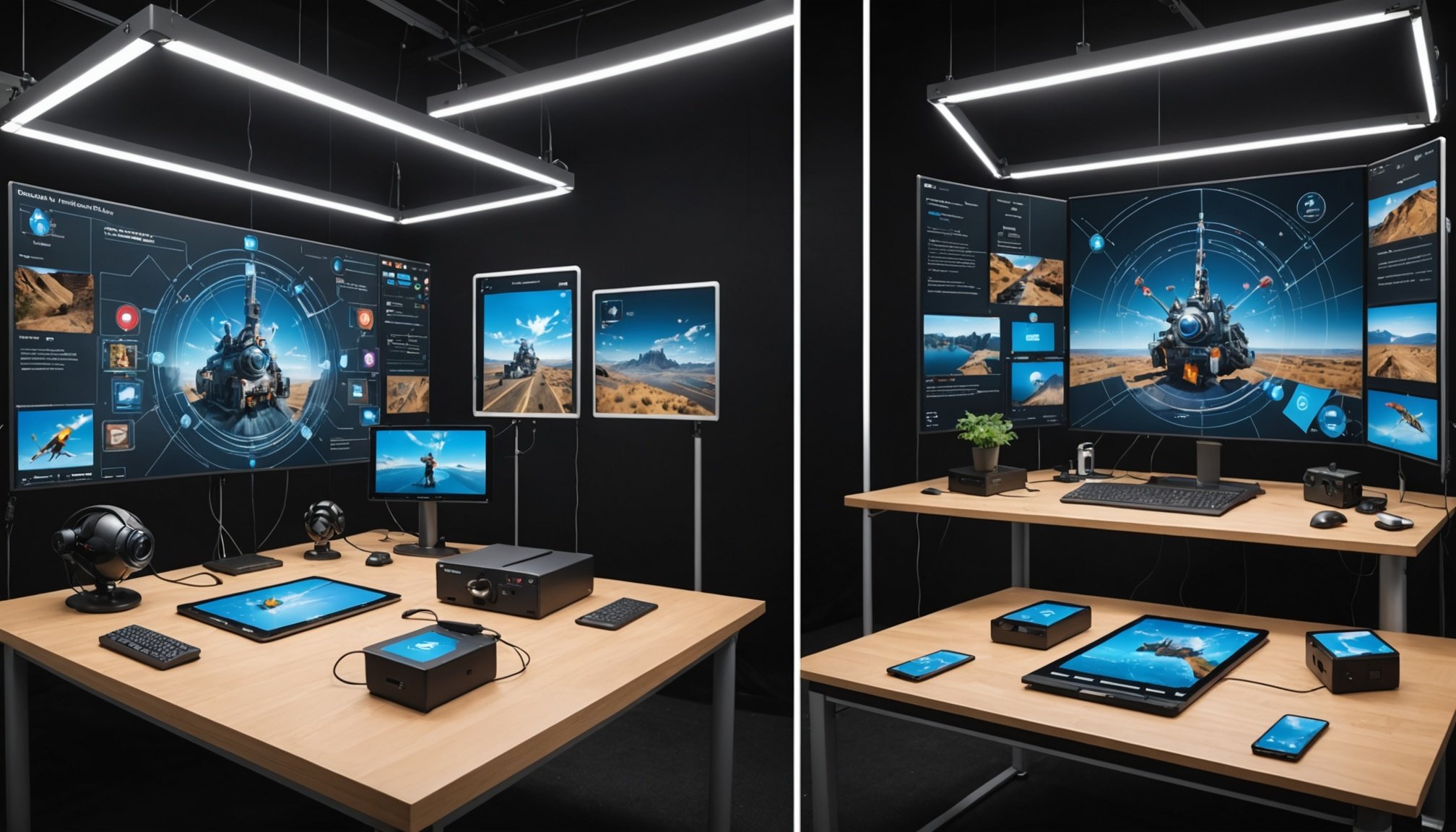Overview of Augmented Reality Gaming and Neural Networks
Augmented Reality (AR) represents a transformative step in gaming, providing a seamless blend of the digital and physical worlds. By superimposing digital content onto the real world, it enhances the player’s experience, making gaming more immersive. AR has become significant due to its ability to facilitate interactive gameplay and bring virtual objects into our world.
Neural Networks form the backbone of many technological advancements, including those in AR gaming. By emulating the human brain’s operations, neural networks process and analyze vast amounts of data. This capability is crucial in developing systems that require real-time analysis and decision-making, such as gaming technology. Neural networks play a pivotal role in refining AR applications by increasing their accuracy and processing speed.
In the same genre : Unlocking Enchanted Forest Realms: Essential Tactics for Crafting Engaging Exploration Adventures
The integration of AR and neural networks signifies a growing trend in gaming technology. This convergence enhances real-time responses and makes games more dynamic and engaging. As neural networks evolve, their implementation in AR games suggests significant future developments. They promise to push the boundaries of what is achievable, offering exciting new experiences to players and reshaping the landscape of digital entertainment. These advancements hold the promise of richer user interactions and a revolutionized gaming experience.
Mechanisms of Object Recognition in AR Gaming
In the realm of augmented reality gaming, object recognition is a core feature that transforms gameplay. This technology identifies and interprets objects within the player’s environment, allowing virtual elements to interact with the real world. Real-time processing is crucial in this context, ensuring the game responds swiftly and accurately to changing surroundings.
Also read : Transforming Roguelike Game Design Through Machine Learning: Unleashing the Power of Procedural Creativity
Understanding Object Recognition Technology
Object recognition technology serves as a bridge between reality and virtual environments in AR. It detects physical objects and uses algorithms to interpret them digitally. This intricate process facilitates seamless interaction between real-world items and virtual overlays, enhancing the player’s immersive experience.
Role of Neural Networks in Object Recognition
Neural networks are pivotal in advancing object recognition. They process complex datasets to enhance the accuracy and speed of recognising objects, thereby ensuring gaming applications provide a more refined experience. The adaptability of neural networks allows them to learn and improve from new data, making them indispensable in dynamic gaming scenarios.
Comparison of Traditional vs. Neural Network Methods
Traditional methods of object recognition relied heavily on pre-coded algorithms that lacked flexibility. The introduction of neural networks has addressed these limitations, providing systems that adapt and deliver more precise results. This evolution marks a significant advancement in AR gaming technology.
Practical Applications of Neural Networks in AR Games
Neural networks are bolstering the capabilities of AR gaming applications with notable improvements in object recognition and real-time processing. These technologies foster dynamic gameplay experiences by actively interpreting and responding to the player’s real-world environment. Through the use of sophisticated algorithms, AR games can deliver more nuanced interactions, deeply enhancing the user experience.
Some existing AR games serve as compelling case studies in this regard. For instance, games that employ neural networks for object recognition offer players a seamless blend of physical and digital realities. By recognising and adapting to environmental cues, these games provide intuitive gameplay mechanics that engage users more completely.
The integration of neural networks benefits the player’s experience by allowing games to handle complex tasks quickly and accurately, fostering a more immersive environment. However, the implementation does come with challenges, such as computational demands and the need for ongoing updates to handle new data effectively.
Despite these challenges, the dynamic enhancements and transformative potential of neural networks in AR games continue to be explored, promising to push the boundaries of gaming technology further and reshape future interactions between players and the gaming world.
Innovations and Future Implications of Neural Networks in AR Gaming
The future of gaming is being reshaped by technological advancements, particularly in the realm of neural network development. As these sophisticated systems evolve, they pave the way for exciting technology innovations in augmented reality (AR) applications. A key trend is the continuous improvement of neural networks, which enhances their ability to process complex datasets with remarkable speed and accuracy. This capability facilitates real-time interactions in AR gaming, making experiences more seamless and engaging.
Emerging trends include the development of specialized neural network architectures tailored for AR. These innovations aim to optimize the efficiency of processing real-world data, enhancing object recognition and interaction within games. As a result, players can expect a more intuitive and immersive gaming experience.
There remains considerable potential for future advancements. Experts predict significant breakthroughs in neural network algorithms that will further refine AR technology. These could lead to novel gameplay mechanics and unprecedented levels of user interaction. Ultimately, these developments will heighten engagement, offering players new ways to connect with both the game and their surroundings. As neural networks continue to advance, they promise to revolutionize the gaming industry and expand the boundaries of digital entertainment.
Challenges and Considerations in Implementing Neural Networks
Building immersive augmented reality (AR) experiences presents numerous challenges, particularly with neural network implementation. These technological systems require substantial computing power, and integrating them within gaming environments can become resource-intensive. Developers often face issues with optimizing algorithms to ensure fast processing speeds, which are crucial for maintaining seamless gaming experiences.
Furthermore, ethical considerations arise with the use of neural networks, often revolving around user data and privacy. As these technologies gather and analyse vast amounts of information, ensuring data protection becomes paramount. Developers must be conscientious about transparency and user consent, respecting privacy whilst delivering engaging activities.
Overcoming these hurdles requires strategic approaches. Developers can adopt several solutions, such as:
- Optimising networks for efficiency to lower computational costs.
- Implementing rigorous data protection protocols to ensure privacy and build trust.
- Enhancing collaboration within the industry to innovate and share best practices.
Implementing neural networks not only adds complexity but also offers unique opportunities for creating interactive gaming environments. By addressing these challenges, developers can refine AR applications, delivering remarkable user experiences while simultaneously safeguarding user trust and data integrity.
Conclusion: The Future of AR Gaming Enhanced by Neural Networks
In the rapidly evolving landscape of augmented reality gaming, the fusion with neural networks has become a pivotal driver of innovation. This development amplifies both the technological impact and the user’s immersion within game worlds. The integration of sophisticated neural network algorithms enables games to process data with unmatched speed and precision, fundamentally transforming user experiences. As these networks continue to refine, they promise an expansion of game dynamics and interactivity.
Neural networks will likely redefine AR gaming, ushering in unprecedented advancements. Enhanced object recognition capabilities, coupled with real-time processing, create seamless interactions between virtual and real-world environments. This innovation broadens the scope for developers, offering new possibilities in game design and fostering player engagement through intuitive gameplay mechanics.
Looking forward, as the technology matures, it stands to significantly shape the future of AR gaming. It can deliver more profound impact by providing unparalleled levels of immersion and interaction. Developers can explore novel storytelling techniques, interactive experiences, and adaptive gameplay by leveraging these technological advances. Overall, the possibilities for creating engaging digital worlds are endless, positioning neural networks as a formidable force in the future of gaming.











